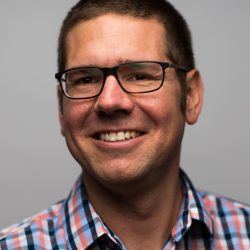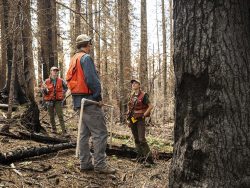
A group of students, accompanied by School of Environmental and Forest Sciences (SEFS) Professor Brian Harvey, look at the centuries-old trees towering around them in an old growth experimental forest plot. This plot was established many years ago and handed down through generations of forest ecologists, through the shift from when forests were studied only as potential sources of lumber to modern forest research that examines forests as complete ecosystems.
Forest research changed over sixty years ago when a young undergraduate at Oregon State University named Jerry Franklin took a position as a student trainee with the U.S. Forest Service. There, he began studying and working with permanent forest plots that were protected from human disturbances, set up by the Forest Service in the 1930’s and 1940’s for research purposes. Franklin, now a SEFS emeritus professor, considers these plots absolutely essential for understanding forest system ecology.
“I was just stunned by the value. The whole idea of setting up permanent plots was something I’d never heard of before. I was just entranced with the idea that this was really the way in which we can see what happened. The only way to see what happened [to the forests],” Franklin said.
The decades of research and insights that Franklin and his colleagues collected through these permanent plots have served to reshape the way that conservation managers, forestry workers and even policymakers view and understand forest ecosystems. Franklin sparked this shift after seeking and receiving funds to study forests in a way that had not been done before, an accomplishment that he describes as an immense source of pride.
“There has been a lot of research done on forests over the years, in the first half of the century forests were only studied as potential crops, not as ecosystems,” Franklin said. “We decided we were going to study a natural forest as an ecosystem, as a complete unit. We picked an old growth forest to do that…it turned out to be not only very, very instructive from the standpoint of understanding forest ecosystems, but also became very relevant to developing conservation strategies that preserved a lot of the existing old growth forest. I’m very proud of that.“
With over six decades of crucial information about forest ecosystems, Franklin says this is just the start. He is passing his research on to younger generations of forest researchers, including Harvey and undergraduate and graduate students.
It is hard to overstate how important Franklin’s contributions have been for understanding forest ecosystems. Part of what makes a forest ecologist’s job so challenging is the timescale over which trees and forests change, grow and mature.

“The ecosystem dynamics play out over timescales that are sometimes hard for us to wrap our minds around,” Harvey said. “It’s really hard to go into a forest during one snapshot of time and say, okay, how is this thing doing?”
Harvey uses a clever analogy to better understand the importance of Franklin’s decades-long work using these permanent plots. Without Franklin’s detailed records, Harvey explained, identifying issues with individual trees or forests would be analogous to a doctor attempting to diagnose someone’s health issue without any of their medical history or records.
“But with these long term records, you’ve got the ability to go in and at any point in time and say, okay, what’s going on? What changes are happening and how does that relate to the longer term trends in the system?” Harvey explained.
Still, while Franklin’s observations and records span decades, that time frame still makes up just a small portion of the lifespan of trees and forests, especially in the Pacific Northwest. That’s why it’s such a big deal that Franklin is working so hard to make sure the records are handed down to this next generation of researchers.
“I think a lot of us on the scientific side of this see ourselves as part of the relay of information,” Harvey said. “I sort of see it like, you know, handing over the baton. It’s almost like if we had to see doctors that were telling us about our health, but those doctors only lived a tenth of our lifespan.”
So in a way, Franklin, those who came before him, and those who will follow in his footsteps are but fleeting “forest doctors” who are piecing together detailed medical history records of the trees and forests that make the Pacific Northwest such a magnificent place.

The opportunities to contribute to this project that Franklin, Harvey and SEFS provides should excite prospective forestry students. The chance to learn from someone like Franklin, a man who has paved the way for forest ecologists around the world and someone who Harvey considers himself lucky to have as a mentor, is something very special.
“Jerry is probably one of the most well known and respected forest ecologists and probably ecologists around the world,” Harvey said. “The concepts and understandings that he’s built about how forest ecosystems work, many of which came from this region but also from other regions as well, have been applied and utilized worldwide for sure.”
Franklin plans on spending his retirement continuing to spread the importance of this work to others. He emphasized the need for this work to continue far into the future, and underscored its importance in relation to climate change.
“It’s very critical,” Franklin stressed. “This kind of information is absolutely critical to any kind of a credible program for using forests as part of a response to climate change.”
Luckily, an energetic and enthusiastic new generation of forest researchers here at UW are already making plans to continue this work far into the future.
Harvey is spearheading a project himself that will also undoubtedly leave a prominent legacy made possible by Franklin. The project involves setting up new permanent plots at areas where forest ecosystems have been decimated — like by fire — and are regrowing from scratch.
“Interesting things are going to happen to these ecosystems and when they happen, you’re going to really wish you would’ve had data over the long run,” Harvey said.
It’s not all the time that you get to start recording the medical history of an old-growth forest at the birth of the forest itself, but for a group of young forest ecologists, decades-old knowledge and research provide context for the rebirth of the next generation of forest researchers.

